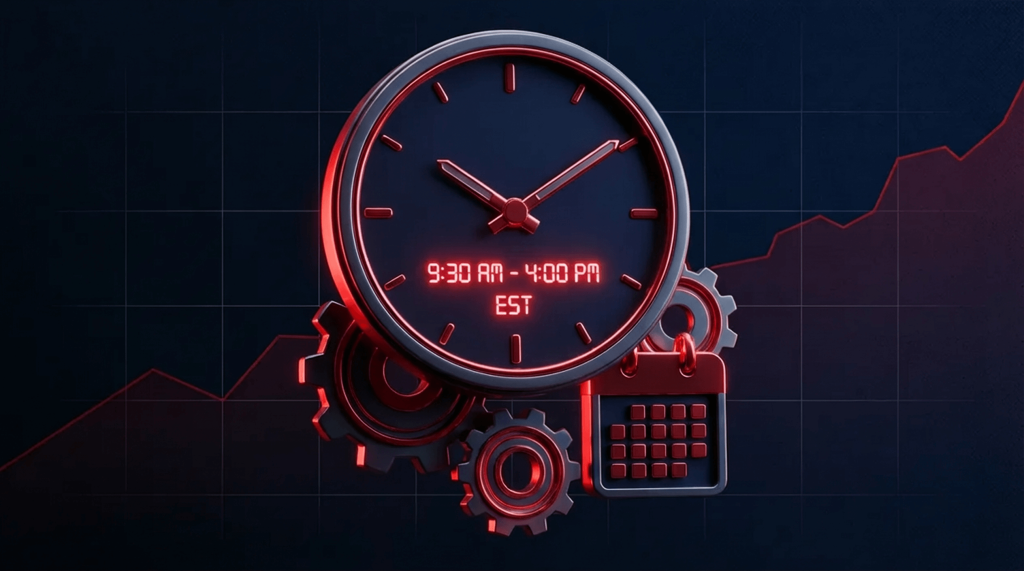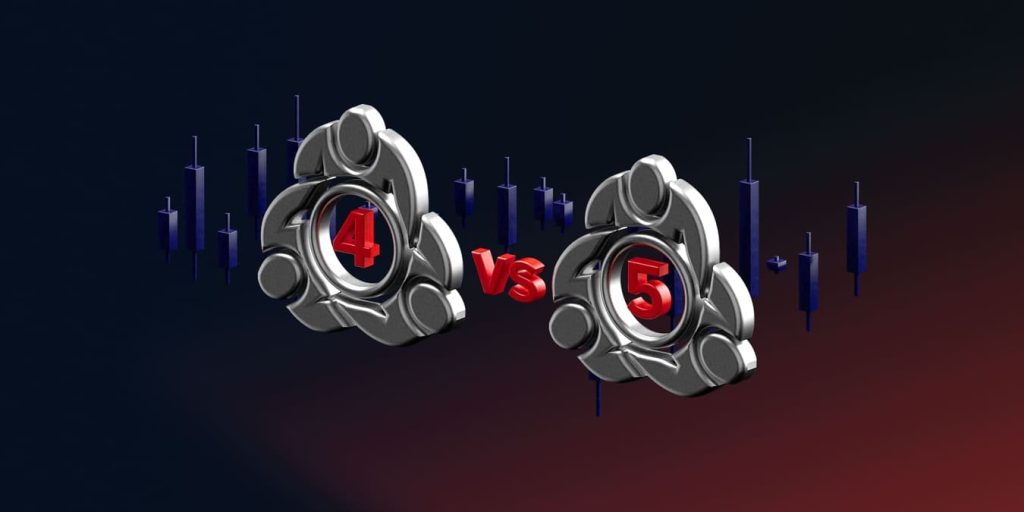
MT4 so với MT5: Sự khác biệt là gì?
Mục lục
Không còn nghi ngờ gì nữa, các nền tảng giao dịch phổ biến nhất trên toàn cầu là MT4 và MT5. MetaTrader 4 ban đầu được thiết kế cho các nhà giao dịch ngoại hối, nhưng đã thay đổi theo thời gian, và MetaTrader 5 được tạo ra để bao gồm cổ phiếu, hợp đồng tương lai, tiền điện tử và hàng hóa. Điều quan trọng là phải hiểu sự khác biệt giữa hai lựa chọn này, vì việc lựa chọn nền tảng giao dịch phù hợp với nhu cầu của họ có thể giúp các nhà giao dịch cải thiện hiệu suất giao dịch và tăng lợi nhuận tổng thể.
Mục đích và Tiếp cận Thị trường
MT4 được thiết kế đặc biệt cho giao dịch tiền tệ fiat. Nền tảng này cung cấp đầy đủ các công cụ phục vụ cho việc thực hiện giao dịch ngoại hối hiệu quả và nghiên cứu thị trường tiền tệ. MT4 cung cấp báo giá theo thời gian thực, biểu đồ chi tiết với nhiều khung thời gian khác nhau và nhiều loại lệnh phù hợp với nhiều phong cách giao dịch khác nhau. Nền tảng hỗ trợ nhiều cặp tiền tệ. Giao diện dễ sử dụng cho phép cả người mới bắt đầu tham gia thị trường ngoại hối và các nhà giao dịch dày dạn kinh nghiệm tìm kiếm những tính năng đáng tin cậy và đơn giản.
Tính năng này đã được cải tiến hơn nữa trong MetaTrader 5. Nền tảng này cho phép giao dịch với nhiều loại tài sản. Người dùng có thể đa dạng hóa danh mục đầu tư của mình trên nhiều loại tài sản khác nhau, nhờ vào khả năng tiếp cận nhiều thị trường tài chính chỉ từ một nền tảng. MT5 cung cấp thông tin chi tiết về thanh khoản thị trường và diễn biến lệnh bằng cách kết nối với cả sàn giao dịch tập trung và thị trường OTC. Các công cụ như công cụ Độ sâu Thị trường cũng có sẵn. Điều này đặc biệt hữu ích cho giao dịch cổ phiếu và tương lai, nơi việc hiểu rõ độ sâu thị trường là vô cùng quan trọng.
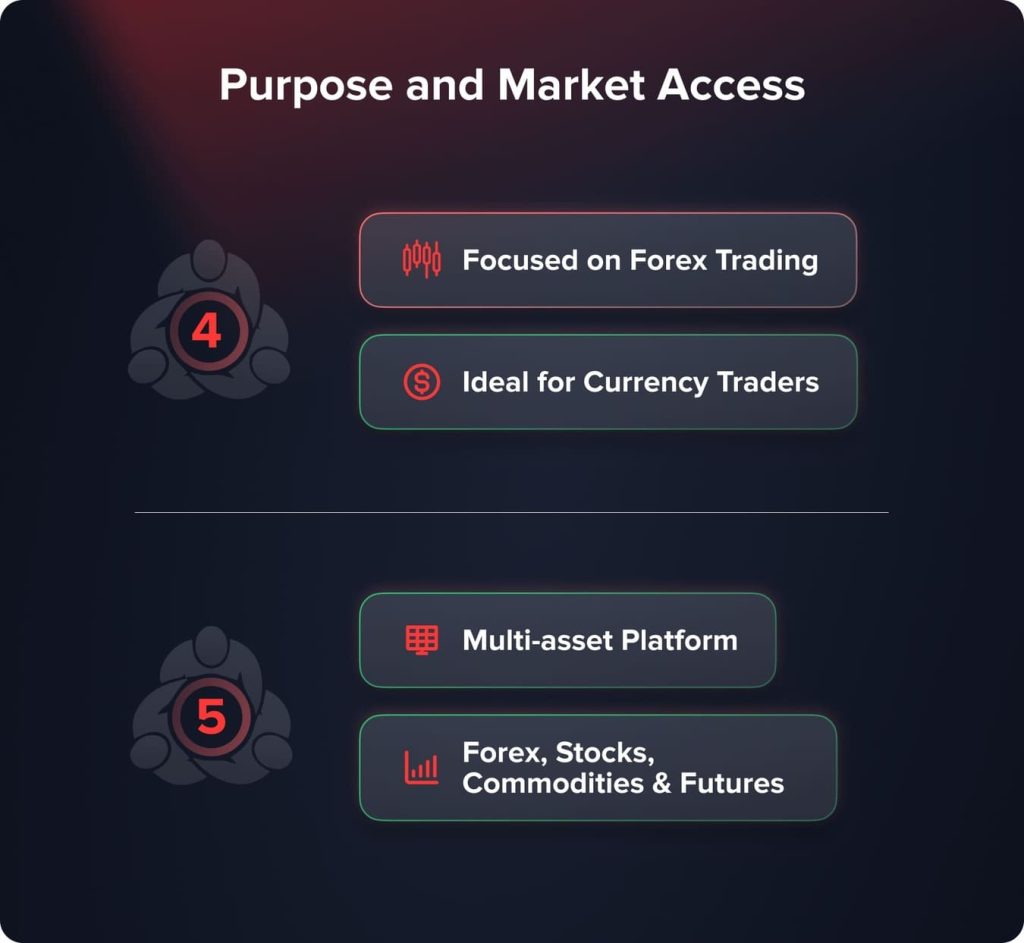
- MT4: Tập trung vào giao dịch ngoại hối; lý tưởng cho các nhà giao dịch tiền tệ.
- MT5: Nền tảng đa tài sản; phù hợp để giao dịch ngoại hối, cổ phiếu, hàng hóa và tương lai.
Công cụ phân tích kỹ thuật và cơ bản
Cùng với các công cụ biểu đồ, MT4 cung cấp cho các nhà giao dịch một loạt các chỉ báo kỹ thuật được thiết kế đặc biệt cho giao dịch ngoại hối. 30 chỉ báo kỹ thuật tích hợp và 31 tính năng đồ họa cung cấp phân tích kỹ thuật toàn diện về các cặp tiền tệ.
MT4 cho phép các nhà giao dịch xem xét các mô hình thị trường trong nhiều giai đoạn bằng cách hỗ trợ chín khung thời gian, từ một phút đến một tháng. Đối với những người có kiến thức lập trình cơ bản, nền tảng này cũng cho phép tùy chỉnh các chỉ báo và tạo chiến lược giao dịch tự động bằng ngôn ngữ lập trình MQL4 khá dễ sử dụng.
Cung cấp 38 các chỉ số kỹ thuật và 44 mục đồ họa, MT5 mở rộng khả năng phân tích này bằng cách cung cấp một loạt công cụ rộng hơn cho nghiên cứu thị trường chuyên sâu. Nó bao gồm 21 khung thời gian, do đó cho phép các nhà giao dịch tự do hơn trong việc phân tích dữ liệu, từ biểu đồ một phút đến các khoảng thời gian hàng tháng.
MT5 hỗ trợ hiển thị đồng thời tới 100 biểu đồ, cho phép theo dõi thị trường và công cụ tài chính toàn diện. Bằng cách cập nhật cho nhà giao dịch về các sự kiện kinh tế và tin tức có thể ảnh hưởng đến các thị trường tài chính khác nhau, MT5 còn tích hợp lịch kinh tế chi tiết và dịch vụ tin tức tài chính trực tiếp vào nền tảng, hỗ trợ phân tích cơ bản.
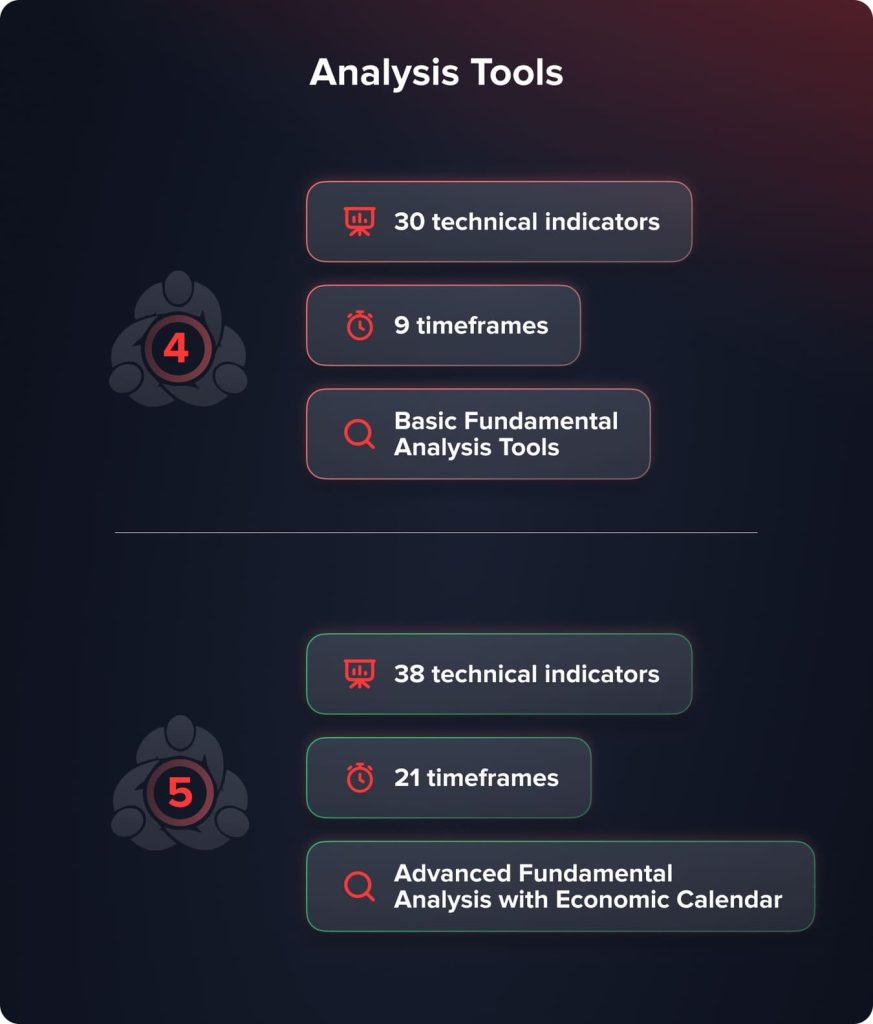
- MT4: 30 chỉ báo kỹ thuật; 9 khung thời gian; các công cụ phân tích cơ bản.
- MT5: 38 chỉ báo kỹ thuật; 21 khung thời gian; phân tích cơ bản nâng cao với lịch kinh tế.
Ngôn ngữ lập trình và giao dịch tự động
Sử dụng Expert Advisors (EA), là các hệ thống được thiết kế để tự động thực hiện các hoạt động giao dịch bằng các thuật toán được xác định trước, cả MT4 và MT5 đều cung cấp tính năng giao dịch tự động. Tuy nhiên, chúng sử dụng các ngôn ngữ lập trình khác nhau, điều này ảnh hưởng đến độ phức tạp và khả năng của các thuật toán có thể được phát triển.
MT4 chạy ngôn ngữ lập trình MQL4. MQL4 có quy trình và khá đơn giản, phù hợp với cả những nhà giao dịch mới bắt đầu lập trình. Nó cho phép người dùng thiết kế các EA và chỉ báo được cá nhân hóa để tự động triển khai các kế hoạch và chiến lược giao dịch khác nhau. Sự đơn giản và hỗ trợ cộng đồng mạnh mẽ của MQL4 giúp dễ dàng tiếp cận nhiều tài liệu, hướng dẫn và EA được xây dựng sẵn.
You may also like
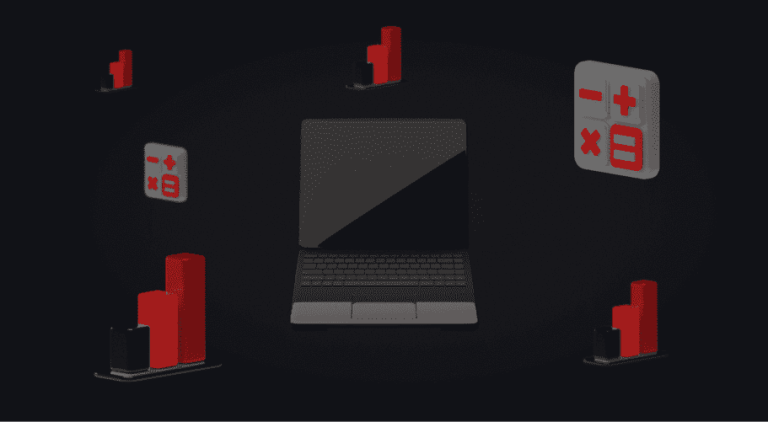
Ngược lại, MT5 sử dụng ngôn ngữ lập trình MQL5. Với khả năng lập trình hướng đối tượng tiên tiến và hỗ trợ lập trình hướng đối tượng, MQL5 giúp tạo ra các robot và chỉ báo giao dịch tinh vi hơn. Các tính năng nâng cao của MQL5 cho phép thiết kế các thuật toán phức tạp và kiểm soát tốt hơn các phương pháp giao dịch khác nhau.
Hơn nữa, MT5 còn tích hợp công cụ kiểm tra chiến lược đa luồng, cho phép kiểm tra ngược nhanh hơn và hiệu quả hơn, đồng thời tối ưu hóa EA trên nhiều cặp tiền tệ và khung thời gian khác nhau. Môi trường kiểm tra tinh vi này cho phép các nhà giao dịch xác minh và tinh chỉnh phương pháp giao dịch tự động của họ một cách chính xác hơn.
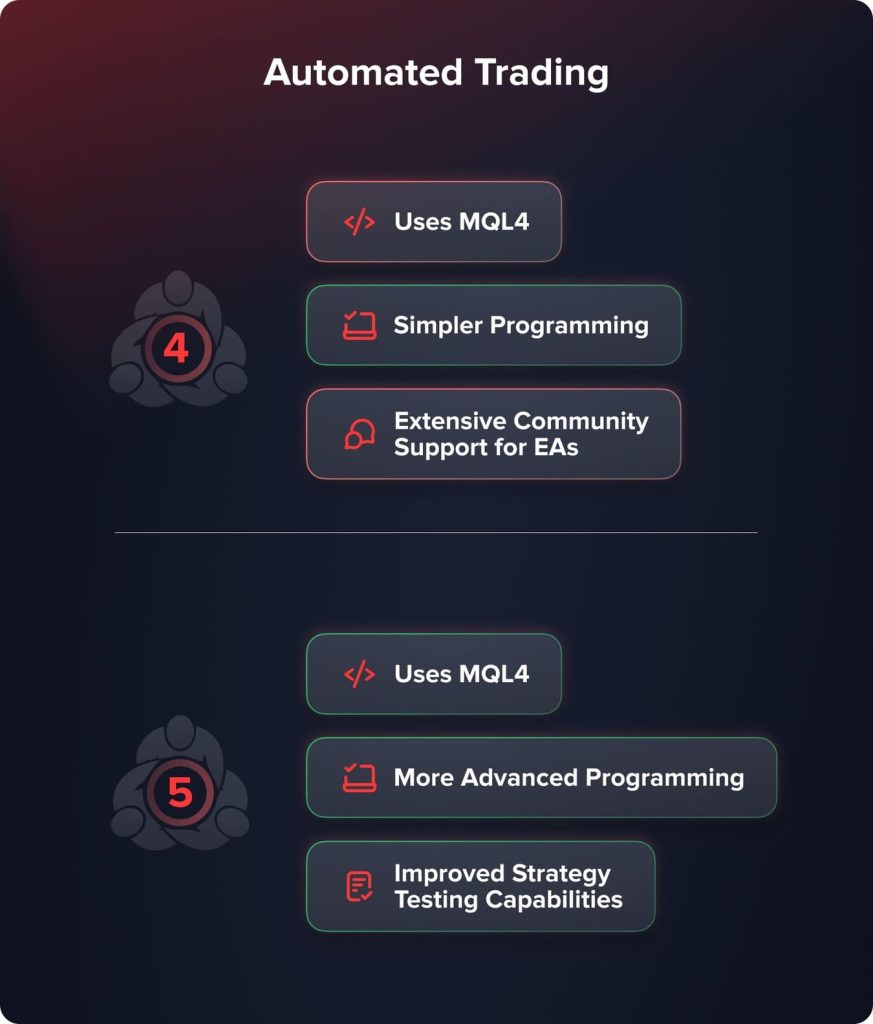
- MT4: Sử dụng MQL4; lập trình đơn giản hơn; cộng đồng hỗ trợ rộng rãi cho EA.
- MT5: Sử dụng MQL5; lập trình tiên tiến hơn; khả năng thử nghiệm chiến lược được cải thiện.
Các loại lệnh và chế độ thực hiện
Buy Limit, Sell Limit, Buy Stop và Sell Stop là bốn hình thức lệnh chờ cơ bản mà MT4 cung cấp cho các nhà giao dịch. Các lệnh này mang lại sự linh hoạt cho nhà giao dịch tùy thuộc vào biến động dự kiến của thị trường bằng cách cho phép họ thực hiện các giao dịch trong tương lai ở các mức giá đã định. Ví dụ: lệnh Buy Limit cho phép nhà giao dịch mua một mặt hàng với giá thấp hơn giá thị trường hiện tại, với hy vọng giá sẽ giảm xuống một mức nhất định trước khi tăng. Mặt khác, lệnh Sell Limit cho phép bạn bán với giá cao hơn giá thị trường hiện tại, với kỳ vọng giá sẽ tăng trước khi giảm.
MT4 cung cấp ba chế độ thực hiện: Thực hiện tức thì, thực hiện giao dịch ở mức giá hiển thị; Thực hiện theo yêu cầu, cho phép nhà giao dịch yêu cầu báo giá trước khi đặt lệnh; và Thực hiện theo thị trường, thực hiện lệnh ở mức giá thị trường hiện tại mà không báo giá lại, ưu tiên tốc độ thực hiện hơn là giá chính xác.
Bằng cách bổ sung thêm hai loại lệnh chờ — Buy Stop Limit và Sell Stop Limit — MT5 mở rộng những đặc điểm này. Kết hợp các phần của lệnh dừng và lệnh giới hạn, các lệnh lai này cho phép nhà giao dịch thiết lập vị trí vào lệnh chính xác hơn và sử dụng các kỹ thuật giao dịch tiên tiến. Khi đạt được mức giá dừng được chỉ định, lệnh Buy Stop Limit, chẳng hạn, sẽ trở thành lệnh Buy Limit, giúp nhà giao dịch có thể kiếm lời từ các biến động dự kiến của thị trường trong tầm kiểm soát tốt hơn.
You may also like
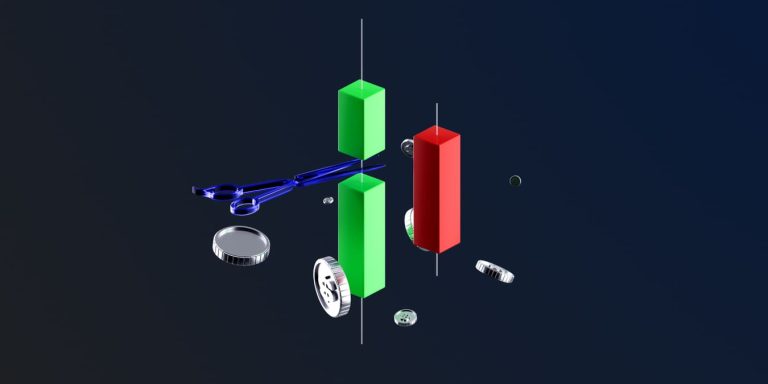
MT5 hiện giới thiệu một tùy chọn thực hiện lệnh bổ sung, rất quan trọng đối với giao dịch trên các sàn giao dịch tập trung như cổ phiếu, hàng hóa và hợp đồng tương lai. Phương pháp này đảm bảo các lệnh được thực hiện theo đúng quy định của sàn giao dịch, do đó cho phép nhà giao dịch truy cập trực tiếp vào thông tin về độ sâu thị trường và thanh khoản.
MT5 cải thiện tính linh hoạt và độ chính xác của giao dịch bằng cách cung cấp nhiều loại lệnh chờ và kỹ thuật thực hiện lệnh hơn. Các kỹ thuật phức tạp hơn được thiết kế riêng cho từng hoàn cảnh thị trường và loại tài sản khác nhau cho phép nhà giao dịch sử dụng. Đặc biệt trong các thị trường biến động nhanh hoặc biến động mạnh, các lựa chọn bổ sung trong MT5 giúp cải thiện quản lý rủi ro và cho phép thực hiện giao dịch hiệu quả hơn, từ đó mang lại lợi ích cho họ.
MT5 cải thiện tính linh hoạt và độ chính xác của giao dịch bằng cách cung cấp một bộ đa dạng hơn các loại lệnh chờ và cơ chế thực hiện. Nhà giao dịch có thể sử dụng các phương pháp tiên tiến hơn phù hợp với các tình huống thị trường nhất định và các loại tài sản Các tùy chọn bổ sung trong MT5 giúp quản lý rủi ro tốt hơn và cho phép thực hiện giao dịch hiệu quả hơn, đặc biệt có lợi trong các thị trường biến động nhanh hoặc dễ biến động.
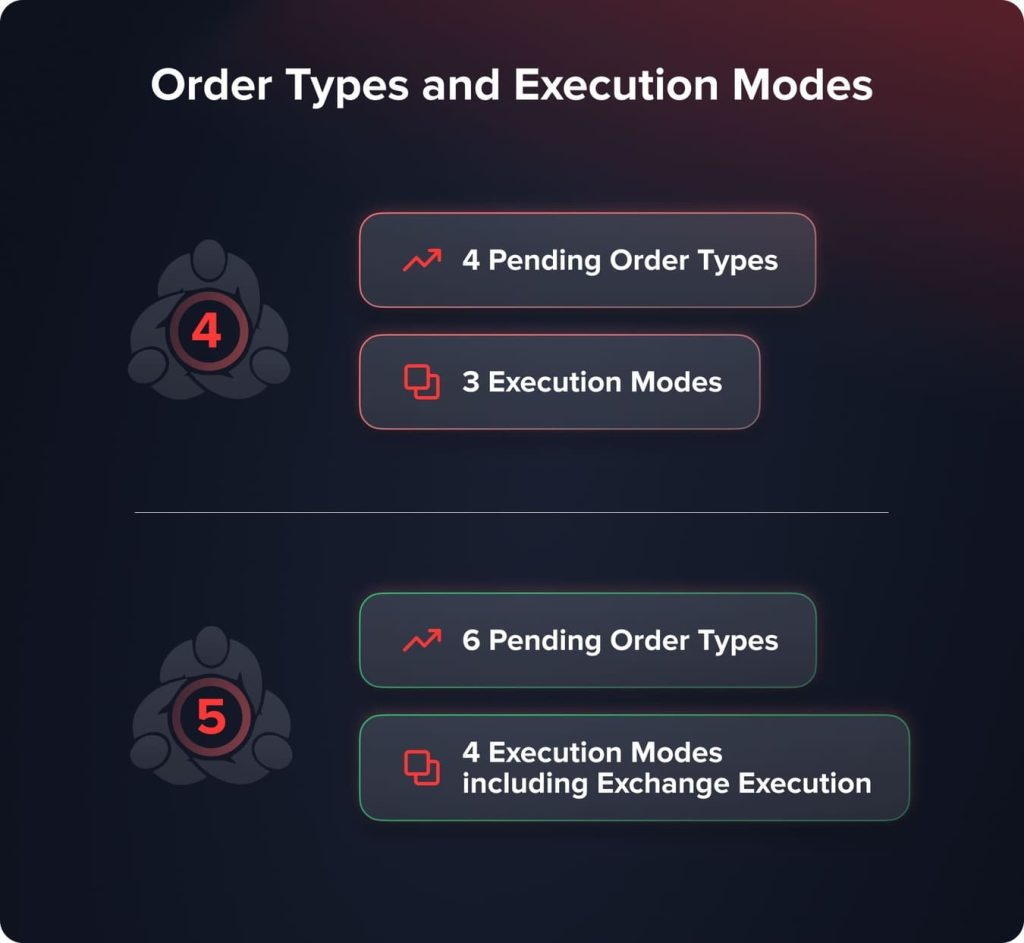
- MT4: 4 loại lệnh chờ; 3 chế độ thực hiện.
- MT5: 6 loại lệnh chờ; 4 chế độ thực hiện bao gồm Exchange Execution.
Hệ thống hàng rào và lưới
Giao dịch phòng ngừa rủi ro (hedging) - một kỹ thuật trong đó các nhà giao dịch mở nhiều vị thế trên cùng một tài sản tài chính theo các hướng khác nhau cùng lúc - được hỗ trợ bởi MT4. Do đó, trên cùng một cặp tiền tệ, nhà giao dịch có thể đồng thời duy trì một vị thế mua (long) cũng như một vị thế bán (short). Các nhà giao dịch Forex thường sử dụng hedging như một kỹ thuật giảm thiểu rủi ro tiêu chuẩn vì nó cho phép họ giảm thiểu tổn thất tiềm ẩn từ những biến động tiêu cực của thị trường mà không cần phải đóng các vị thế ban đầu. Hedging giúp các nhà giao dịch duy trì sự linh hoạt trong chiến thuật giao dịch, kiếm lợi nhuận từ những biến động ngắn hạn của thị trường và bảo vệ tài sản của họ trước sự biến động.
Ban đầu được thiết kế với hệ thống bù trừ, MT5 phù hợp hơn với các thị trường giao dịch trên sàn như cổ phiếu, hàng hóa và hợp đồng tương lai. Các nhà giao dịch theo hệ thống bù trừ chỉ có một vị thế mở cho mỗi sản phẩm tài chính. Nếu một giao dịch mới được thực hiện trên cùng một công cụ, giao dịch đó sẽ đóng hoặc thay đổi vị thế hiện tại thay vì tạo ra một giao dịch riêng biệt. Phương pháp này được áp dụng rộng rãi trên các thị trường mà hoạt động phòng ngừa rủi ro không được sử dụng rộng rãi hoặc không được cho phép, và tuân thủ các quy tắc của nhiều sàn giao dịch tập trung.
You may also like

Tuy nhiên, trước nhu cầu lớn của cộng đồng giao dịch, MT5 giờ đây cũng hỗ trợ hedging. Sự cải tiến này cho phép các nhà giao dịch quyết định phương pháp hedging và netting nào phù hợp nhất với nhu cầu cụ thể và thị trường giao dịch của họ. Thông qua việc hỗ trợ hedging, MT5 mang đến cho các nhà giao dịch ngoại hối và những người khác sử dụng phương pháp này cơ hội kiểm soát rủi ro tốt hơn. Nhà giao dịch có thể mở nhiều vị thế không giới hạn trên cùng một công cụ, theo cùng hướng hoặc ngược hướng, mà không bị hạn chế.
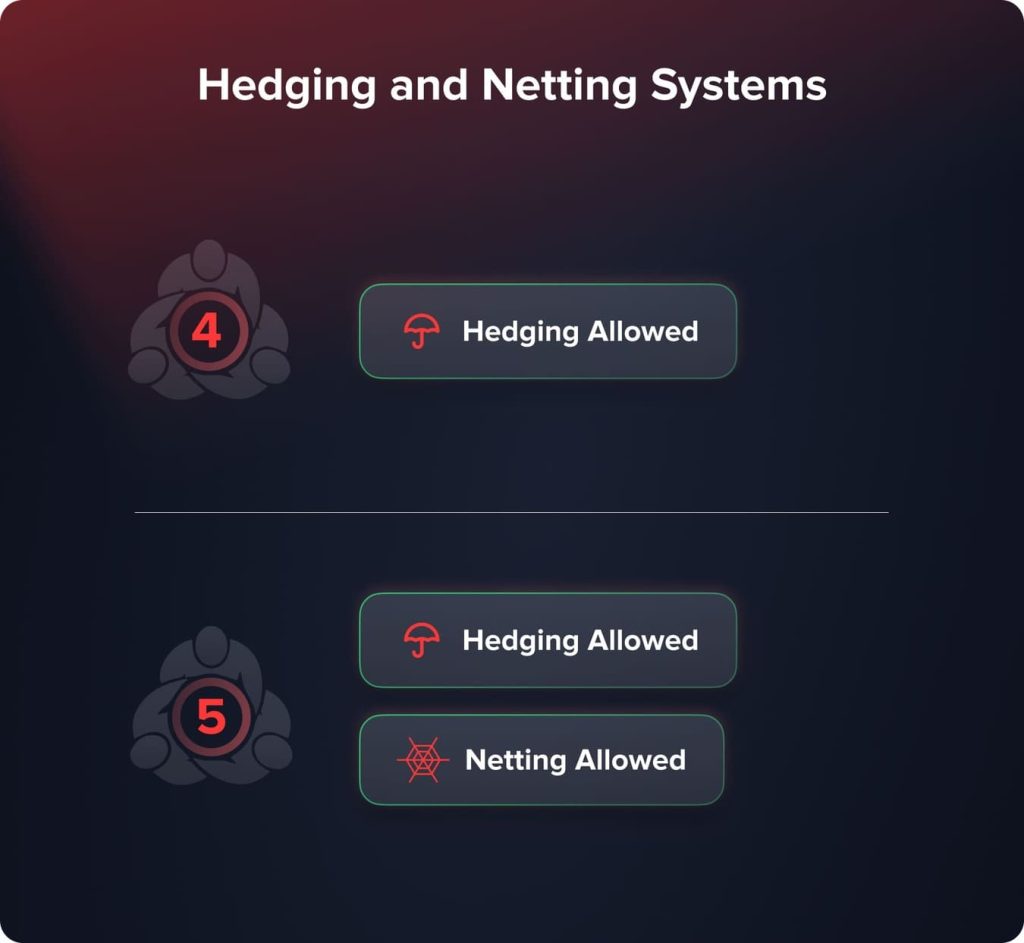
- MT4: Cho phép phòng ngừa rủi ro.
- MT5: Hỗ trợ cả hệ thống phòng ngừa rủi ro và hệ thống bù trừ.
Giao diện và trải nghiệm người dùng
Nổi tiếng với sự đơn giản và dễ sử dụng, MT4 sở hữu giao diện rõ ràng, thu hút các nhà giao dịch ở nhiều trình độ kiến thức khác nhau. Thiết kế của nền tảng nhấn mạnh vào khả năng truy cập và tiện ích, mang đến cho người dùng một bố cục gọn gàng, dễ dàng tìm thấy các công cụ và yếu tố quan trọng. Các thanh công cụ và biểu đồ có thể tùy chỉnh trên giao diện người dùng của MT4 cho phép nhà giao dịch điều chỉnh không gian làm việc theo sở thích mà không cần thêm bất kỳ yếu tố phức tạp không cần thiết nào. Sự đơn giản này khiến MT4 đặc biệt hấp dẫn đối với các nhà giao dịch mới, vì nó rút ngắn thời gian học hỏi và cho phép họ thực hiện giao dịch một cách tự tin.
Hơn nữa, MT4 sử dụng ít tài nguyên hệ thống hơn, đảm bảo hoạt động liền mạch ngay cả trên các hệ thống yếu hơn hoặc lỗi thời. Nhiều nhà giao dịch sử dụng MT4 vì hiệu quả của nó giúp giảm thiểu các vấn đề công nghệ có thể ảnh hưởng đến hoạt động giao dịch.
Với nhiều tính năng hơn và khả năng tùy chỉnh được cải thiện, MT5 mang đến trải nghiệm người dùng hiện đại và tinh tế hơn. Nền tảng này được thiết kế để mang đến trải nghiệm người dùng nâng cao, đáp ứng nhu cầu của các nhà giao dịch cần các chức năng phức tạp hơn và khả năng kiểm soát tốt hơn môi trường giao dịch của họ. Các tính năng biểu đồ mở rộng của giao diện MT5 cho phép người dùng truy cập vào nhiều giai đoạn và công cụ phân tích hơn, đồng thời hiển thị nhiều biểu đồ cùng lúc.
Chương trình cũng cung cấp khả năng quản lý lệnh và thông tin chuyên sâu về thị trường, do đó cung cấp cho các nhà giao dịch dữ liệu đầy đủ ngay trong tầm tay. Mặc dù giao diện nâng cao của MT5 mang lại độ sâu phân tích và tính linh hoạt cao hơn, nhưng nó có thể cần nhiều tài nguyên tính toán hơn, điều này sẽ ảnh hưởng đến hiệu suất trên các hệ thống kém hiệu quả hoặc cũ hơn. Nếu phần cứng của họ không đáp ứng được các yêu cầu hệ thống ngày càng cao của nền tảng, các nhà giao dịch có thể gặp phải thời gian tải lâu hơn hoặc phản hồi chậm hơn.
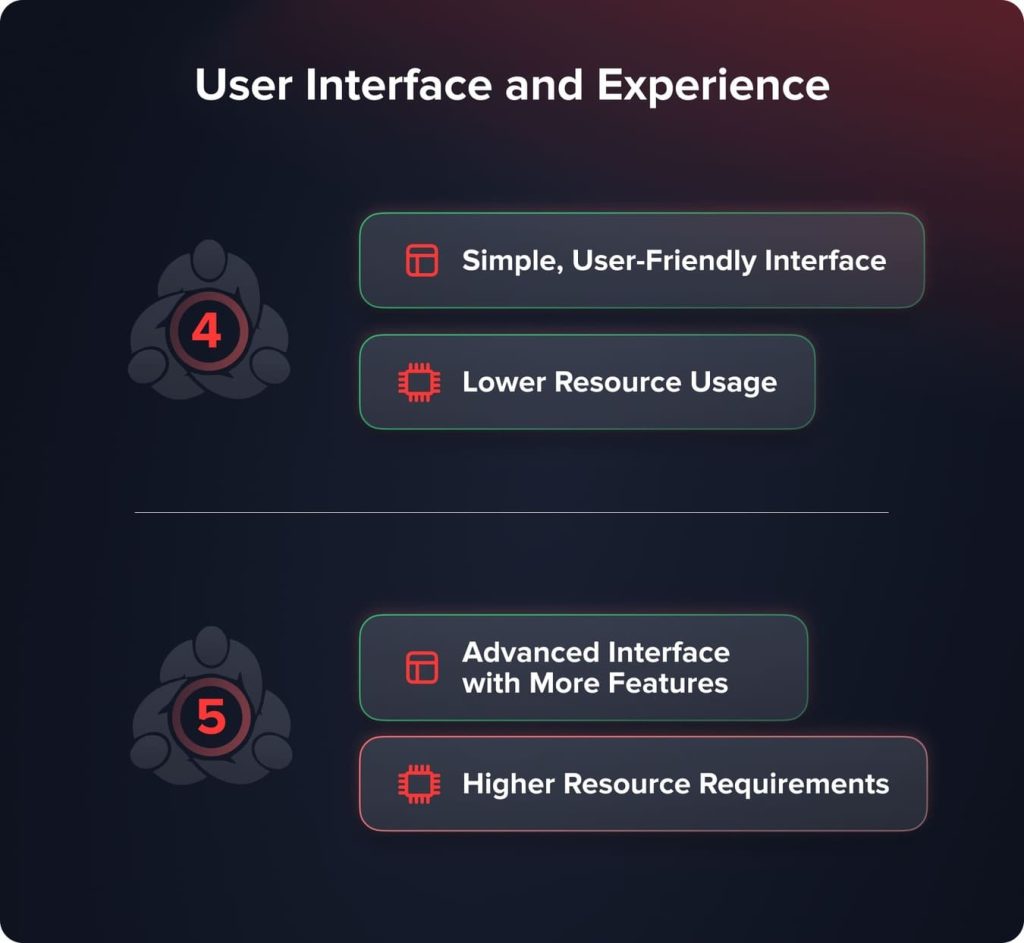
- MT4: Giao diện đơn giản, thân thiện với người dùng; sử dụng ít tài nguyên hơn.
- MT5: Giao diện nâng cao với nhiều tính năng hơn; yêu cầu tài nguyên cao hơn.
Khả năng tương thích và hỗ trợ
Trong nhiều năm, MT4 đã trở thành tiêu chuẩn công nghiệp cho các hệ thống giao dịch; các nhà môi giới trên toàn thế giới ủng hộ mạnh mẽ nền tảng này. Độ tin cậy và tuổi thọ cao của nó đã tạo nên một cộng đồng người dùng đông đảo, góp phần xây dựng nên một hệ sinh thái khổng lồ gồm các plugin độc lập, chỉ báo tùy chỉnh và EA.
Cơ sở tài nguyên phong phú này cho phép các nhà giao dịch cải thiện và cá nhân hóa đáng kể môi trường giao dịch của họ. MT4 rất quen thuộc, do đó các tài nguyên hướng dẫn, bài hướng dẫn và hỗ trợ cộng đồng đều dễ dàng tiếp cận cho các nhà giao dịch ở mọi cấp độ. Các nhà môi giới đánh giá cao thành tích vững chắc và kỹ năng tích hợp mượt mà của nền tảng, giúp đảm bảo vị thế thống trị liên tục của MT4 trong lĩnh vực giao dịch ngoại hối.
Mặc dù MT5 ngày càng phổ biến, nhưng nó vẫn chưa đạt được mức độ hỗ trợ toàn cầu như MT4. Do những thay đổi lớn về cơ sở hạ tầng và lượng người dùng ổn định của MT4, một số sàn giao dịch vẫn còn ngần ngại chấp nhận MT5. Tuy nhiên, nhu cầu về các tính năng nâng cao và khả năng giao dịch đa tài sản mà MT5 mang lại đang thúc đẩy sự chấp nhận ngày càng tăng. Các sàn giao dịch đang mở rộng sản phẩm của mình để tích hợp MT5 khi các nhà giao dịch muốn tiếp cận với nhiều công cụ tài chính hơn và các công cụ phân tích tiên tiến hơn buộc họ phải làm như vậy.
Tính khả dụng của các công cụ, plugin và EA của bên thứ ba đang được mở rộng khi ngày càng nhiều người dùng chuyển sang MT5. Mặc dù không mở rộng như hệ sinh thái của MT4, hệ thống hỗ trợ của MT5 đang phát triển nhanh chóng và cung cấp cho các nhà giao dịch nhiều công cụ hơn để cải thiện chiến lược giao dịch của họ.
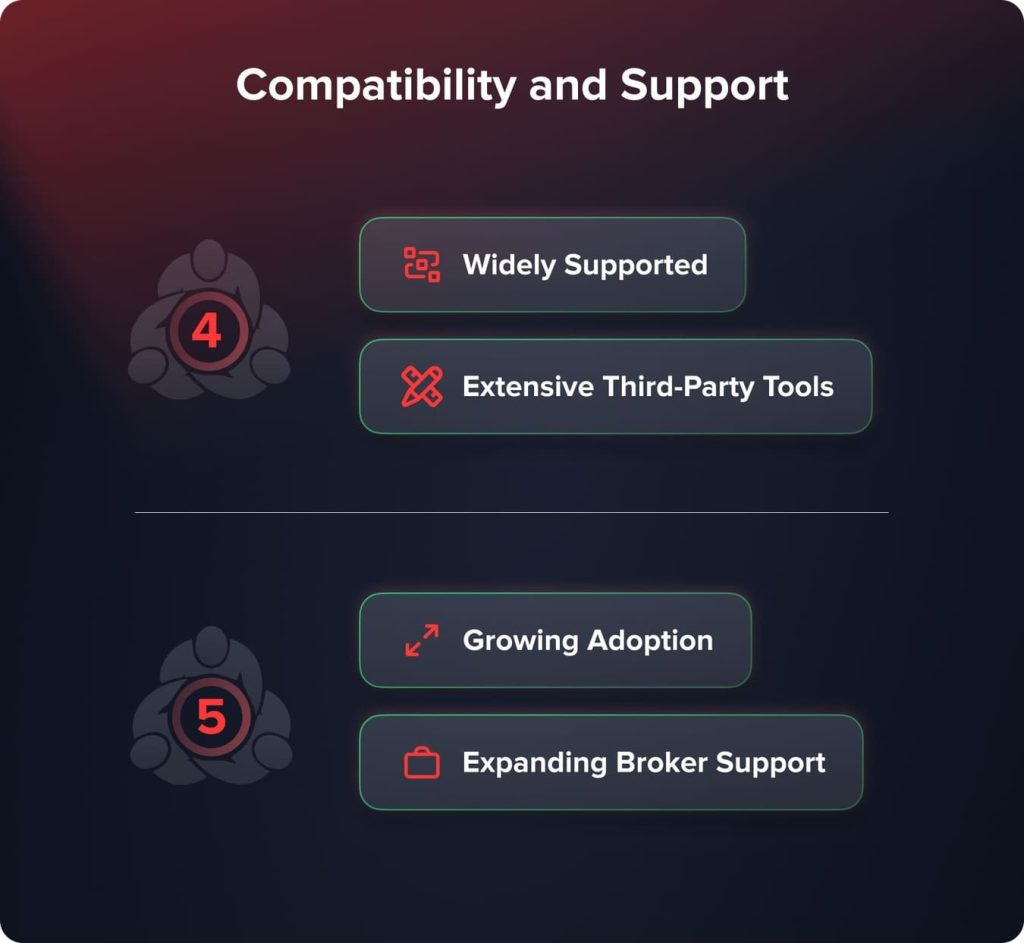
- MT4: Được hỗ trợ rộng rãi; có nhiều công cụ của bên thứ ba.
- MT5: Tăng cường áp dụng; mở rộng hỗ trợ môi giới.
Phần kết luận
Việc lựa chọn nền tảng phù hợp nhất với mục tiêu giao dịch của bạn phụ thuộc vào việc hiểu rõ sự khác biệt giữa MT4 và MT5. Các nhà giao dịch Forex vẫn đánh giá MT4 là một lựa chọn mạnh mẽ và đáng tin cậy; đối với những người muốn giao dịch đa tài sản, MT5 cung cấp nhiều lựa chọn hơn. Việc tìm hiểu các công cụ và đặc điểm cụ thể của bất kỳ nền tảng nào có thể giúp bạn đưa ra lựa chọn sáng suốt và cải thiện thành công giao dịch.
FAQ
Các nhà giao dịch ngoại hối muốn một nền tảng đơn giản, thân thiện với người dùng, có nhiều hỗ trợ cộng đồng và ít cần tài nguyên hơn có thể thấy MT4 phù hợp hơn. Đối với những người giao dịch trên nhiều thị trường, MT5 cung cấp các công cụ tinh vi, giao dịch đa tài sản và chức năng nâng cao. Cuối cùng, MT5 phù hợp hơn với những người dùng cần nhiều tính năng nâng cao hơn và tiếp cận nhiều thị trường hơn.
Các nhà giao dịch sử dụng cả hai hệ thống cho biết MT4 và MT5 có ngôn ngữ lập trình riêng. Điểm khác biệt là ngôn ngữ lập trình của MT4 dễ sử dụng, phát triển và cài đặt hơn, khiến nó trở nên hoàn hảo cho các nhà giao dịch thiếu kinh nghiệm vì chỉ cần vài bước để cấu hình các tính năng.
Bạn thực sự có thể giao dịch đồng thời trên cả nền tảng MT4 và MT5. Bạn sẽ phải thiết lập tài khoản giao dịch riêng cho từng nền tảng vì tài khoản MT4 và MT5 không thể hoán đổi cho nhau do sự khác biệt về kiến trúc và định dạng dữ liệu.
Đã cập nhật:
19 tháng 12, 2024

